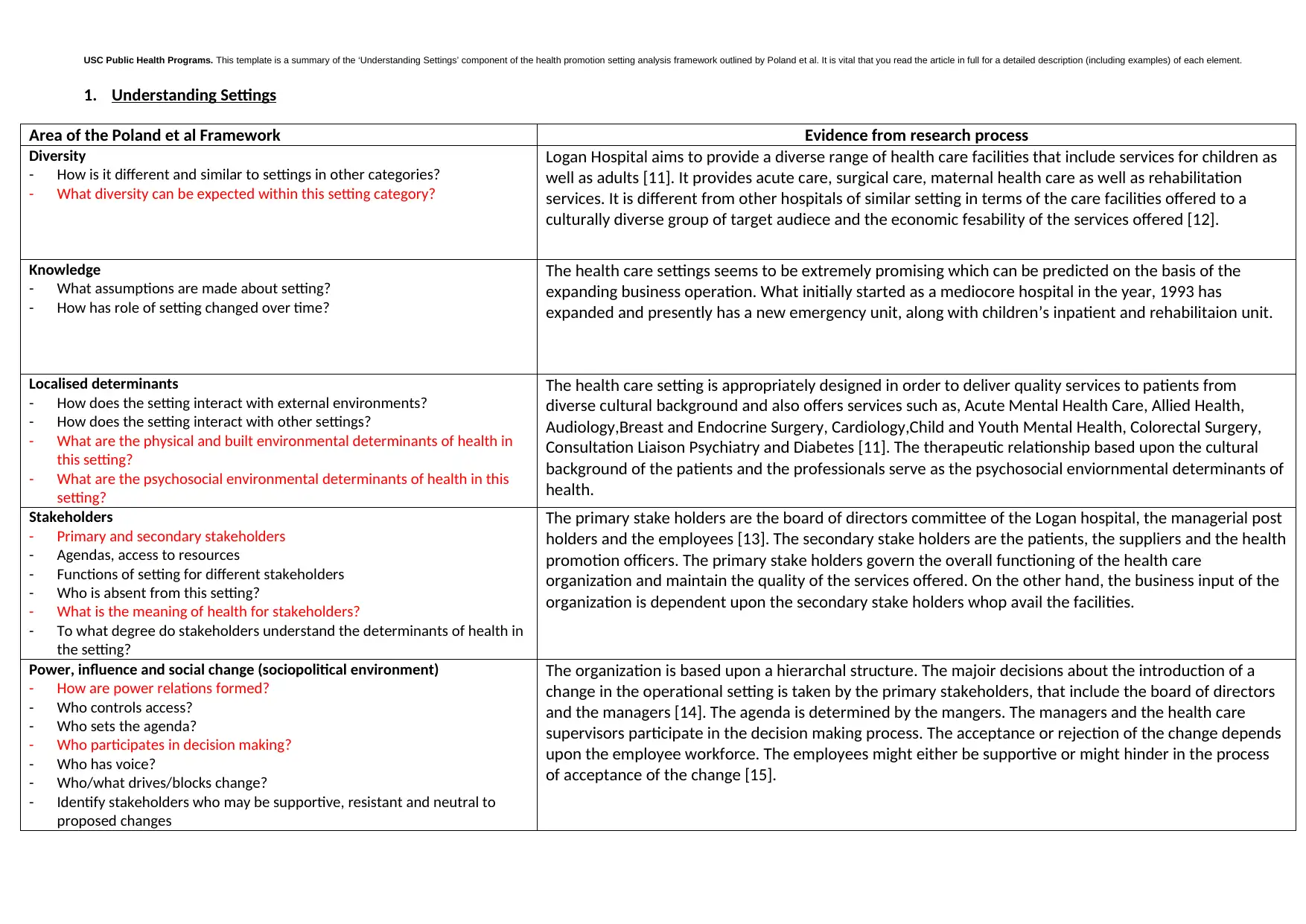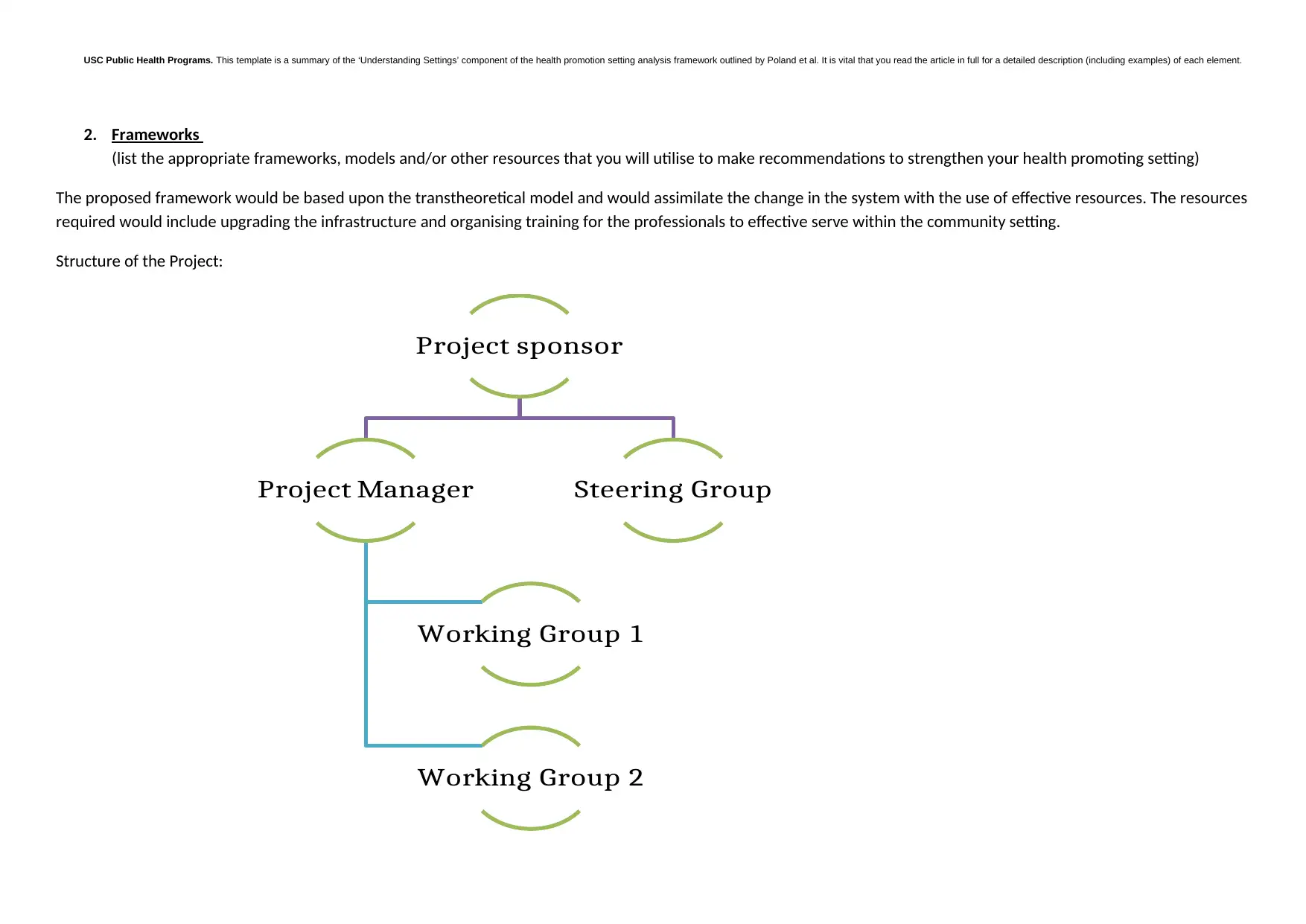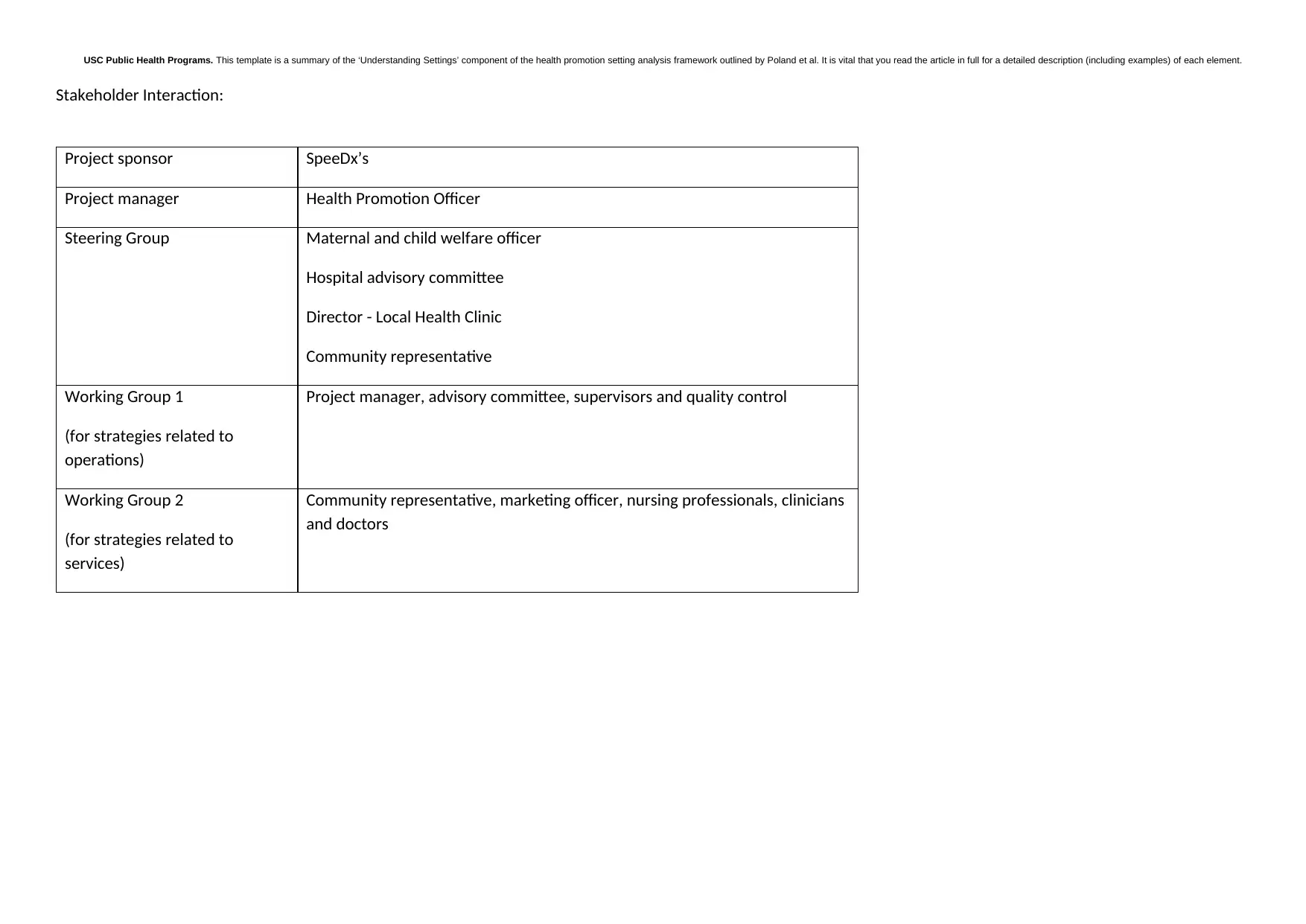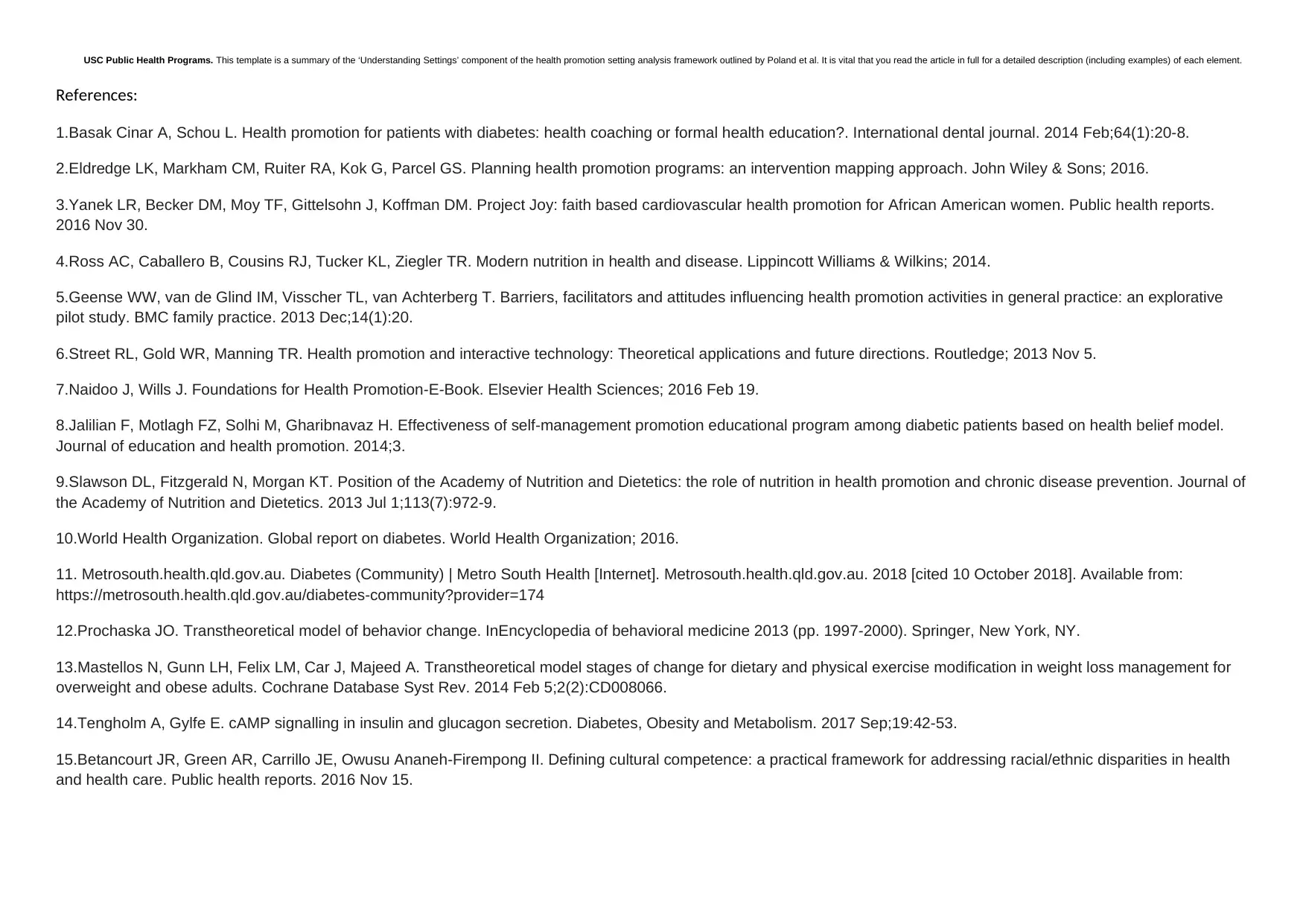USC Public Health Programs: Health Promotion Setting Analysis Report
VerifiedAdded on 2023/06/04
|4
|1491
|82
Report
AI Summary
This report presents a health promotion setting analysis within the context of USC Public Health Programs, utilizing the framework outlined by Poland et al. It examines the diversity, knowledge, and localized determinants within a healthcare setting, specifically Logan Hospital, highlighting its services and cultural diversity. The analysis identifies primary stakeholders (board of directors, managers, employees) and secondary stakeholders (patients, suppliers, health promotion officers), detailing their roles and influence. Power dynamics and decision-making processes are explored, with a focus on how changes are implemented and accepted within the organization. Furthermore, the report proposes a framework based on the transtheoretical model, emphasizing resource allocation and professional training. It outlines stakeholder interactions and governance structures, including project sponsors, managers, steering groups, and working groups. The document also includes a strategy plan table, aligning strategies with relevant domains and evidence-based practices to strengthen health promotion efforts, referencing various studies and guidelines to support the analysis and proposed interventions.

USC Public Health Programs. This template is a summary of the ‘Understanding Settings’ component of the health promotion setting analysis framework outlined by Poland et al. It is vital that you read the article in full for a detailed description (including examples) of each element.
1. Understanding Settings
Area of the Poland et al Framework Evidence from research process
Diversity
- How is it different and similar to settings in other categories?
- What diversity can be expected within this setting category?
Logan Hospital aims to provide a diverse range of health care facilities that include services for children as
well as adults [11]. It provides acute care, surgical care, maternal health care as well as rehabilitation
services. It is different from other hospitals of similar setting in terms of the care facilities offered to a
culturally diverse group of target audiece and the economic fesability of the services offered [12].
Knowledge
- What assumptions are made about setting?
- How has role of setting changed over time?
The health care settings seems to be extremely promising which can be predicted on the basis of the
expanding business operation. What initially started as a mediocore hospital in the year, 1993 has
expanded and presently has a new emergency unit, along with children’s inpatient and rehabilitaion unit.
Localised determinants
- How does the setting interact with external environments?
- How does the setting interact with other settings?
- What are the physical and built environmental determinants of health in
this setting?
- What are the psychosocial environmental determinants of health in this
setting?
The health care setting is appropriately designed in order to deliver quality services to patients from
diverse cultural background and also offers services such as, Acute Mental Health Care, Allied Health,
Audiology,Breast and Endocrine Surgery, Cardiology,Child and Youth Mental Health, Colorectal Surgery,
Consultation Liaison Psychiatry and Diabetes [11]. The therapeutic relationship based upon the cultural
background of the patients and the professionals serve as the psychosocial enviornmental determinants of
health.
Stakeholders
- Primary and secondary stakeholders
- Agendas, access to resources
- Functions of setting for different stakeholders
- Who is absent from this setting?
- What is the meaning of health for stakeholders?
- To what degree do stakeholders understand the determinants of health in
the setting?
The primary stake holders are the board of directors committee of the Logan hospital, the managerial post
holders and the employees [13]. The secondary stake holders are the patients, the suppliers and the health
promotion officers. The primary stake holders govern the overall functioning of the health care
organization and maintain the quality of the services offered. On the other hand, the business input of the
organization is dependent upon the secondary stake holders whop avail the facilities.
Power, influence and social change (sociopolitical environment)
- How are power relations formed?
- Who controls access?
- Who sets the agenda?
- Who participates in decision making?
- Who has voice?
- Who/what drives/blocks change?
- Identify stakeholders who may be supportive, resistant and neutral to
proposed changes
The organization is based upon a hierarchal structure. The majoir decisions about the introduction of a
change in the operational setting is taken by the primary stakeholders, that include the board of directors
and the managers [14]. The agenda is determined by the mangers. The managers and the health care
supervisors participate in the decision making process. The acceptance or rejection of the change depends
upon the employee workforce. The employees might either be supportive or might hinder in the process
of acceptance of the change [15].
1. Understanding Settings
Area of the Poland et al Framework Evidence from research process
Diversity
- How is it different and similar to settings in other categories?
- What diversity can be expected within this setting category?
Logan Hospital aims to provide a diverse range of health care facilities that include services for children as
well as adults [11]. It provides acute care, surgical care, maternal health care as well as rehabilitation
services. It is different from other hospitals of similar setting in terms of the care facilities offered to a
culturally diverse group of target audiece and the economic fesability of the services offered [12].
Knowledge
- What assumptions are made about setting?
- How has role of setting changed over time?
The health care settings seems to be extremely promising which can be predicted on the basis of the
expanding business operation. What initially started as a mediocore hospital in the year, 1993 has
expanded and presently has a new emergency unit, along with children’s inpatient and rehabilitaion unit.
Localised determinants
- How does the setting interact with external environments?
- How does the setting interact with other settings?
- What are the physical and built environmental determinants of health in
this setting?
- What are the psychosocial environmental determinants of health in this
setting?
The health care setting is appropriately designed in order to deliver quality services to patients from
diverse cultural background and also offers services such as, Acute Mental Health Care, Allied Health,
Audiology,Breast and Endocrine Surgery, Cardiology,Child and Youth Mental Health, Colorectal Surgery,
Consultation Liaison Psychiatry and Diabetes [11]. The therapeutic relationship based upon the cultural
background of the patients and the professionals serve as the psychosocial enviornmental determinants of
health.
Stakeholders
- Primary and secondary stakeholders
- Agendas, access to resources
- Functions of setting for different stakeholders
- Who is absent from this setting?
- What is the meaning of health for stakeholders?
- To what degree do stakeholders understand the determinants of health in
the setting?
The primary stake holders are the board of directors committee of the Logan hospital, the managerial post
holders and the employees [13]. The secondary stake holders are the patients, the suppliers and the health
promotion officers. The primary stake holders govern the overall functioning of the health care
organization and maintain the quality of the services offered. On the other hand, the business input of the
organization is dependent upon the secondary stake holders whop avail the facilities.
Power, influence and social change (sociopolitical environment)
- How are power relations formed?
- Who controls access?
- Who sets the agenda?
- Who participates in decision making?
- Who has voice?
- Who/what drives/blocks change?
- Identify stakeholders who may be supportive, resistant and neutral to
proposed changes
The organization is based upon a hierarchal structure. The majoir decisions about the introduction of a
change in the operational setting is taken by the primary stakeholders, that include the board of directors
and the managers [14]. The agenda is determined by the mangers. The managers and the health care
supervisors participate in the decision making process. The acceptance or rejection of the change depends
upon the employee workforce. The employees might either be supportive or might hinder in the process
of acceptance of the change [15].
Paraphrase This Document
Need a fresh take? Get an instant paraphrase of this document with our AI Paraphraser

USC Public Health Programs. This template is a summary of the ‘Understanding Settings’ component of the health promotion setting analysis framework outlined by Poland et al. It is vital that you read the article in full for a detailed description (including examples) of each element.
2. Frameworks
(list the appropriate frameworks, models and/or other resources that you will utilise to make recommendations to strengthen your health promoting setting)
The proposed framework would be based upon the transtheoretical model and would assimilate the change in the system with the use of effective resources. The resources
required would include upgrading the infrastructure and organising training for the professionals to effective serve within the community setting.
Structure of the Project:
Project sponsor
Project Manager
Working Group 1
Working Group 2
Steering Group
2. Frameworks
(list the appropriate frameworks, models and/or other resources that you will utilise to make recommendations to strengthen your health promoting setting)
The proposed framework would be based upon the transtheoretical model and would assimilate the change in the system with the use of effective resources. The resources
required would include upgrading the infrastructure and organising training for the professionals to effective serve within the community setting.
Structure of the Project:
Project sponsor
Project Manager
Working Group 1
Working Group 2
Steering Group

USC Public Health Programs. This template is a summary of the ‘Understanding Settings’ component of the health promotion setting analysis framework outlined by Poland et al. It is vital that you read the article in full for a detailed description (including examples) of each element.
Stakeholder Interaction:
Project sponsor SpeeDx’s
Project manager Health Promotion Officer
Steering Group Maternal and child welfare officer
Hospital advisory committee
Director - Local Health Clinic
Community representative
Working Group 1
(for strategies related to
operations)
Project manager, advisory committee, supervisors and quality control
Working Group 2
(for strategies related to
services)
Community representative, marketing officer, nursing professionals, clinicians
and doctors
Stakeholder Interaction:
Project sponsor SpeeDx’s
Project manager Health Promotion Officer
Steering Group Maternal and child welfare officer
Hospital advisory committee
Director - Local Health Clinic
Community representative
Working Group 1
(for strategies related to
operations)
Project manager, advisory committee, supervisors and quality control
Working Group 2
(for strategies related to
services)
Community representative, marketing officer, nursing professionals, clinicians
and doctors
⊘ This is a preview!⊘
Do you want full access?
Subscribe today to unlock all pages.

Trusted by 1+ million students worldwide

USC Public Health Programs. This template is a summary of the ‘Understanding Settings’ component of the health promotion setting analysis framework outlined by Poland et al. It is vital that you read the article in full for a detailed description (including examples) of each element.
References:
1.Basak Cinar A, Schou L. Health promotion for patients with diabetes: health coaching or formal health education?. International dental journal. 2014 Feb;64(1):20-8.
2.Eldredge LK, Markham CM, Ruiter RA, Kok G, Parcel GS. Planning health promotion programs: an intervention mapping approach. John Wiley & Sons; 2016.
3.Yanek LR, Becker DM, Moy TF, Gittelsohn J, Koffman DM. Project Joy: faith based cardiovascular health promotion for African American women. Public health reports.
2016 Nov 30.
4.Ross AC, Caballero B, Cousins RJ, Tucker KL, Ziegler TR. Modern nutrition in health and disease. Lippincott Williams & Wilkins; 2014.
5.Geense WW, van de Glind IM, Visscher TL, van Achterberg T. Barriers, facilitators and attitudes influencing health promotion activities in general practice: an explorative
pilot study. BMC family practice. 2013 Dec;14(1):20.
6.Street RL, Gold WR, Manning TR. Health promotion and interactive technology: Theoretical applications and future directions. Routledge; 2013 Nov 5.
7.Naidoo J, Wills J. Foundations for Health Promotion-E-Book. Elsevier Health Sciences; 2016 Feb 19.
8.Jalilian F, Motlagh FZ, Solhi M, Gharibnavaz H. Effectiveness of self-management promotion educational program among diabetic patients based on health belief model.
Journal of education and health promotion. 2014;3.
9.Slawson DL, Fitzgerald N, Morgan KT. Position of the Academy of Nutrition and Dietetics: the role of nutrition in health promotion and chronic disease prevention. Journal of
the Academy of Nutrition and Dietetics. 2013 Jul 1;113(7):972-9.
10.World Health Organization. Global report on diabetes. World Health Organization; 2016.
11. Metrosouth.health.qld.gov.au. Diabetes (Community) | Metro South Health [Internet]. Metrosouth.health.qld.gov.au. 2018 [cited 10 October 2018]. Available from:
https://metrosouth.health.qld.gov.au/diabetes-community?provider=174
12.Prochaska JO. Transtheoretical model of behavior change. InEncyclopedia of behavioral medicine 2013 (pp. 1997-2000). Springer, New York, NY.
13.Mastellos N, Gunn LH, Felix LM, Car J, Majeed A. Transtheoretical model stages of change for dietary and physical exercise modification in weight loss management for
overweight and obese adults. Cochrane Database Syst Rev. 2014 Feb 5;2(2):CD008066.
14.Tengholm A, Gylfe E. cAMP signalling in insulin and glucagon secretion. Diabetes, Obesity and Metabolism. 2017 Sep;19:42-53.
15.Betancourt JR, Green AR, Carrillo JE, Owusu Ananeh-Firempong II. Defining cultural competence: a practical framework for addressing racial/ethnic disparities in health
and health care. Public health reports. 2016 Nov 15.
References:
1.Basak Cinar A, Schou L. Health promotion for patients with diabetes: health coaching or formal health education?. International dental journal. 2014 Feb;64(1):20-8.
2.Eldredge LK, Markham CM, Ruiter RA, Kok G, Parcel GS. Planning health promotion programs: an intervention mapping approach. John Wiley & Sons; 2016.
3.Yanek LR, Becker DM, Moy TF, Gittelsohn J, Koffman DM. Project Joy: faith based cardiovascular health promotion for African American women. Public health reports.
2016 Nov 30.
4.Ross AC, Caballero B, Cousins RJ, Tucker KL, Ziegler TR. Modern nutrition in health and disease. Lippincott Williams & Wilkins; 2014.
5.Geense WW, van de Glind IM, Visscher TL, van Achterberg T. Barriers, facilitators and attitudes influencing health promotion activities in general practice: an explorative
pilot study. BMC family practice. 2013 Dec;14(1):20.
6.Street RL, Gold WR, Manning TR. Health promotion and interactive technology: Theoretical applications and future directions. Routledge; 2013 Nov 5.
7.Naidoo J, Wills J. Foundations for Health Promotion-E-Book. Elsevier Health Sciences; 2016 Feb 19.
8.Jalilian F, Motlagh FZ, Solhi M, Gharibnavaz H. Effectiveness of self-management promotion educational program among diabetic patients based on health belief model.
Journal of education and health promotion. 2014;3.
9.Slawson DL, Fitzgerald N, Morgan KT. Position of the Academy of Nutrition and Dietetics: the role of nutrition in health promotion and chronic disease prevention. Journal of
the Academy of Nutrition and Dietetics. 2013 Jul 1;113(7):972-9.
10.World Health Organization. Global report on diabetes. World Health Organization; 2016.
11. Metrosouth.health.qld.gov.au. Diabetes (Community) | Metro South Health [Internet]. Metrosouth.health.qld.gov.au. 2018 [cited 10 October 2018]. Available from:
https://metrosouth.health.qld.gov.au/diabetes-community?provider=174
12.Prochaska JO. Transtheoretical model of behavior change. InEncyclopedia of behavioral medicine 2013 (pp. 1997-2000). Springer, New York, NY.
13.Mastellos N, Gunn LH, Felix LM, Car J, Majeed A. Transtheoretical model stages of change for dietary and physical exercise modification in weight loss management for
overweight and obese adults. Cochrane Database Syst Rev. 2014 Feb 5;2(2):CD008066.
14.Tengholm A, Gylfe E. cAMP signalling in insulin and glucagon secretion. Diabetes, Obesity and Metabolism. 2017 Sep;19:42-53.
15.Betancourt JR, Green AR, Carrillo JE, Owusu Ananeh-Firempong II. Defining cultural competence: a practical framework for addressing racial/ethnic disparities in health
and health care. Public health reports. 2016 Nov 15.
1 out of 4
Related Documents
Your All-in-One AI-Powered Toolkit for Academic Success.
+13062052269
info@desklib.com
Available 24*7 on WhatsApp / Email
![[object Object]](/_next/static/media/star-bottom.7253800d.svg)
Unlock your academic potential
Copyright © 2020–2025 A2Z Services. All Rights Reserved. Developed and managed by ZUCOL.





